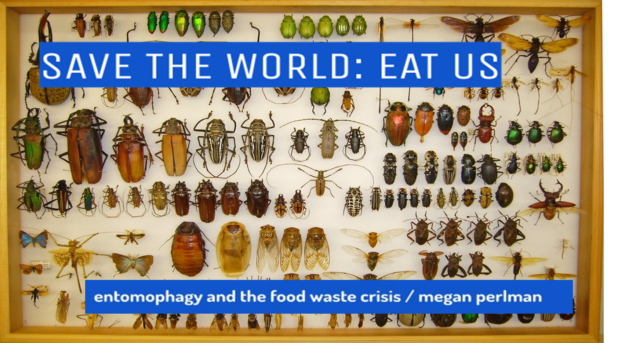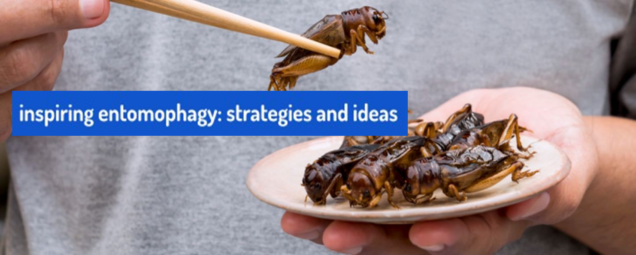Saving the Planet in a Tasty(?) Way: Eat Bugs
Today, we are highlighting work from students in Steven Finn’s course: MET ML626 – Food Waste: Scope, Scale, and Signals for Sustainable Change. This post comes from Megan Perlman.
With the world’s population forecast to reach nine billion by 2050, food production will have to nearly double to keep up. Yet our planet simply cannot provide the water, land, and resources to sustain us at this pace. Livestock, especially beef, is a particularly inefficient use of resources per calorie consumed.

Enter: micro-livestock. The United Nations’ Food and Agriculture Organization’s groundbreaking 2013 paper, Edible Insects: Future Prospects for Food and Feed Security suggests that entomophagy can help food security and the planet.
In fact, simply diversifying our protein sources to include insects can aid in the achievement of many of the UN’s 17 Sustainable Development Goals (SDGs) – including goals 2: Zero Hunger; 6: Clean Water and Sanitation; 12: Responsible Consumption and Production; and 15: Life on Land.
Insects are highly sustainable. They take up little space, are easy to care for, and use very few resources (both environmentally and economically). They are nutritionally dense with protein, and minerally rich. Their benefits are far-reaching and can help slow some of our resource depletion quite quickly. Insects can offer the same protein and mineral content as regular meat or fish — but at far less cost to the planet.
So why don’t we eat them? Well, bugs are gross. Contrary to all reason, the cultural “ick” factor seems the hardest to overcome, even though over two billion people globally already eat insects. Insects are arthropods, like lobster and shrimp. It’s completely arbitrary that in the Western world lobster is a delicacy and beetles are not – and it hasn’t always been that way either (at least not for the lobster). In fact, we are already eating insect products in our everyday foods (cochineal red dye and lac bugs confectioners’ glaze in food and candy, for example).
Restaurants and the culinary world have been early adopters – chef José Andrés has been serving chapulines (grasshopper tacos) at his Mexican restaurant Oyamel for 20 years, simply because it is a Oaxacan classic. Condé Nast’s Epicurious website amassed 4.7 million views on their 2022 video of chef Joseph Yoon demonstrating different ways to cook 19 edible insects.

Marketing and awareness can help gain tremendous amounts of traction in normalizing entomophagy. Cultural norms are ingrained, but still moveable. Here are five strategies to move the needle:
1. Lower the Barrier to Entry
Containing up to 70% protein by weight, as well as vitamins and minerals such as iron and vitamin B12 with a neutral flavor, cricket flour is a safe and healthy on-ramp for those hesitant to eat an insect whole.
- Create and publish recipes using cricket flour.
- Stock cricket flour widely in grocery stores to normalize and associate it with other specialty flours (like Bob’s Red Mill).
2. Focus on Health
Edible insects may have superior health benefits due to their high levels of vitamin B12, iron, zinc, fiber, essential amino acids, omega-3 and omega-6 fatty acids, and antioxidants.
- Reach out to gyms, nutritionists, dieticians, hospitals, and health insurance companies to promote the health benefits of entomophagy to their clients.
- Promote protein bars using insect protein to be sold in health stores and gyms.
3. Appeal to Activists
Eating insects helps people and the planet, so courting influencers/activists is a good angle to spread awareness and cultivate entomophagy evangelists.
- Engage NGOs and non-profits whose interests align with entomophagy to assist in outreach, such as environmental, sustainability, hunger, food waste and conservation organizations.
- Create compelling marketing materials specific to particular goals, such as sustainability, health and nutrition, and low-cost food solutions.
4. Position Entomophagy as Cutting Edge in Haute Cuisine
Promote insects as a new frontier in cuisine, breaking boundaries and exploring culinary innovation.
- Offer groundbreaking chefs education on edible insect preparation and provide opportunities to create tasting menus using insects.
- James Beard Awards: invite nominated chefs to feature insects in the gala menu, introducing the entire fine-dining community to entomophagy with one meal.
- BU Gastronomy Program: invite a visiting professor to create a class on entomophagy, focusing on both the culinary aspect and the sustainability of insects as a food source.
5. Affect Change in Policy
Engage in lobbying to create impact at the policy level.
- Create regulatory framework for growing and selling insects.
- Advocate for food regulations so restaurants can serve edible insects without health code violations.
- Provide subsidies/incentives for insect farmers and manufacturers who market insect protein.